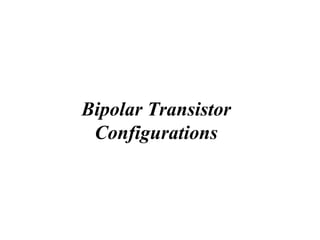
Transistor Amplifier Configuration.ppt
- 2. As the Bipolar Transistor is a three-terminal device, there are basically three possible ways to connect it within an electronic circuit with one terminal being common to both the input and output. Each method of connection responding differently to its input signal within a circuit as the static characteristics of the transistor vary with each circuit arrangement. • Common Base Configuration – has Voltage Gain but no Current Gain • Common Emitter Configuration – has both Current and Voltage Gain • Common Collector Configuration – has Current Gain but no Voltage Gain
- 4. • The common-base (CB) amplifier provides high voltage gain with a maximum current gain of 1. • Since it has a low input resistance, the CB amplifier is the most appropriate type for certain applications where sources tend to have very low-resistance outputs.
- 8. Characteristics of Common Base Transistor Amplifier Configurations Common base Phase Angle Zero (0°) Input terminal Emitter Output terminal Collector Voltage gain High Current gain Low (ratio of collector current & emitter current) Power gain Low Input impedence Low Output impedence High
- 9. • To describe the behavior of common-base amplifiers requires two set of characteristics: - Input or driving point characteristics. - Output or collector characteristics • The output characteristics has 3 basic regions: - Active region –defined by the biasing arrangements - Cutoff region – region where the collector current is 0A - Saturation region- region of the characteristics to the left of VCB = 0V
- 11. Alpha(): • In the dc mode the level of IC and IE due to the majority carriers are related by a quantity called alpha = So, IC = IE • For ac situations where the point of operation moves on the characteristics curve, an ac alpha defined by • Alpha a common base current gain factor that shows the efficiency by calculating the current percent from current flow from emitter to collector. The value of is typical from 0.9 ~ 0.998. E C I I E C I I
- 22. Characteristics of Common Emitter Transistor Amplifier
- 23. Common Emitter Transistor Amplifier
- 25. • The common-collector (CC) amplifier is usually referred to as an emitter-follower (EF). • The input is applied to the base through a coupling capacitor, and the output is at the emitter. • The voltage gain of a CC amplifier is approximately 1, and its main advantages are its high input resistance and current gain.
- 26. • An emitter-follower circuit with voltage-divider bias is shown in Figure 6–25. • Notice that the input signal is capacitively coupled to the base, the output signal is capacitively coupled from the emitter, and the collector is at ac ground. • There is no phase inversion, and the output is approximately the same amplitude as the input.
- 32. Characteristics of Common Collector Transistor Amplifier
- 33. CHARACTERISTICS COMMON BASE COMMON EMITTER COMMON COLLECTOR Current Gain Nearly unity (α) High (β) Highest (1+β) Voltage Gain High Very high Nearly unity Power Gain Moderate Highest Lowest Input Impedance Lowest Moderate Highest Output Impedance Highest Moderate Lowest Phase Reversal No Yes No Comparison of Amplifiers Configuration